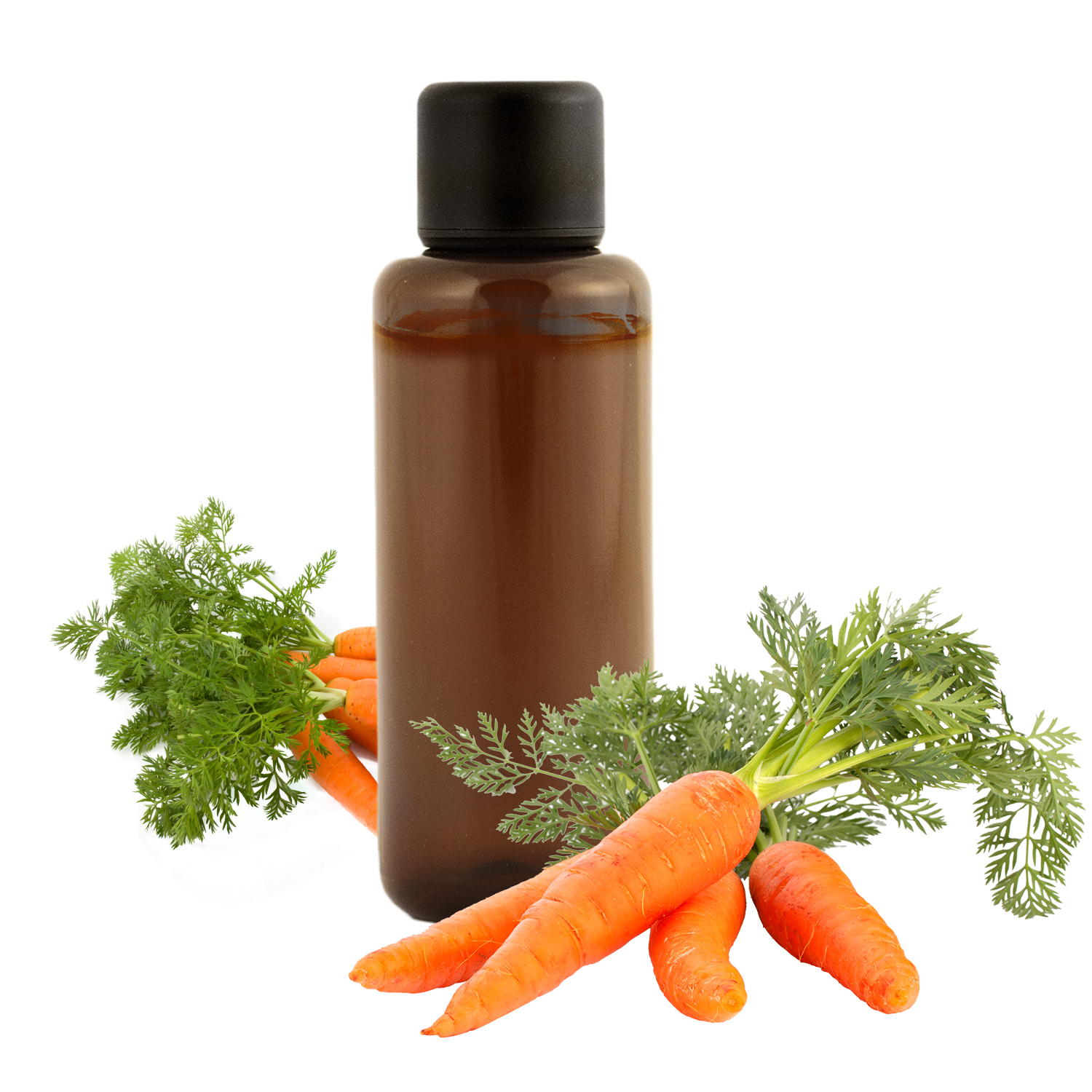
To benefit from the unique virtues of the carrot's constituents, its roots are macerated in sunflower oil. An oily macerate is then obtained, bringing joy to all fans of relaxing in the sun! Due to its natural provitamin A content, oily carrot macerate is in fact one of the best natural self-tanners, and thanks to its moisturizing properties, it will also constitute a perfect after-sun. Finally, it will restore all its radiance to dull and tired skin. Latin name: Daucus carota L. Part used: roots
This article was updated on 26/01/2024Main properties
-
anti-oxidant :
its provitamin A content makes this oily macerate a very good antioxidant, it will capture free radicals and thus fight against the effects of aging.
-
skin protector :
rich in linoleic and oleic acid, the oily macerate of Carrot helps nourish and maintain good hydration of the skin, thus strengthening its hydrolipidic film
-
healthy glow effect :
the orange coloring of the oily carrot macerate will restore color to the skin. Promoting a tanned complexion, it is also a perfect preparation for tanning.
-
softener :
it helps maintain the elastic structure of the skin. This is also one of the reasons why it fits perfectly into anti-aging preparations.
Characteristics and composition
Cosmetic features
- Skin type: mature, acne-prone, dull.
- Hair type: dull, dry, damaged.
Organoleptic characteristics
- Appearance: oily liquid
- Color: yellow to orange
- Odor: weak.
- Touch: dry.
Characteristics for formulation
- Unsaponifiable and active ingredients: β-carotene (provitamin A).
- Comedogenicity index: 1 (=low comedogenic)
- Average saponification index: 188
- Oxidation stability: sensitive
- Inci name: daucus carota sativa root extract
Fatty acid composition
- linoleic acid (omega 6 PUFA): 48 to 74%
- oleic acid (omega 9 MUFA): 14 to 40%
- palmitic acid (AGS): 4 to 9%
- stearic acid (SFA): 1 to 7%
Physical characteristics
- Density at 20°C: 0.880 to 0.920
- Flash point: 175
- Peroxide value: 25
- Acid number: 0.500
Botanical characteristics
- Botanical family: Apiaceae
- Country of origin: Metropolitan France.
- Distilled part: roots
- Obtaining process: maceration in sunflower oil
- Latin name: Daucus carota L.
Precautions for use
Authorized ways of use
Authorized users
Storage
Store preferably in a cool place, away from light and heat.
In case of Dull skin
Efficiency: ++++
Carrot oily macerate is rich in carotenoids, a family of natural pigments responsible for the color of certain fruits and vegetables. They give them a color that can range from yellow-orange to red-purple. We find them in carrots of course, but also in tomatoes or apricots for example. In the carrot and in its oily macerate, we find more particularly beta-carotene, which has benefits for the body... In particular that of giving a healthy glow, of awakening the complexion!
-
Application advice :
massage a few drops of oily Carrot macerate morning and evening onto the skin.
-
Other suitable vegetable oils :
the oil of Apricot kernels it also contains carotenoids for a healthy glow!
For the Tanning (preparation for)
Efficiency: +++
The oily carrot macerate helps prepare the skin for the sun. Indeed, the beta-carotene it contains participates in the activation of the synthesis of melanin, the natural pigments of the skin. This helps strengthen the skin's protection against the sun's UV rays, and thus better prepares it for sun exposure. In addition, its richness in fatty acids allows it to nourish the skin and soften it, in this way it helps prolong the tan. Be careful though, the oily carrot macerate does not replace the protection of sunscreen!
-
Application advice :
apply the oily carrot macerate in small touches to the areas of the body to be prepared and rub in well.
-
Other suitable vegetable oils :
other vegetable oils are suitable for preparing the skin for tanning such as Apricot kernels, the oil of Buriti or the oil of Sea Buckthorn Pulp.
For the Mature skin
Efficiency: ++
In addition to having a healthy glow, the beta-carotene present in the oily macerate of Carrot gives it anti-oxidant properties, helping to protect skin cells against free radicals. The Sunflower oil in which the Carrot is macerated also provides softening and softening properties. Carrot oily macerate therefore helps prevent wrinkles and beautify the skin.
-
Application advice :
massage a few drops of oily Carrot macerate morning and evening onto the skin.
-
Complementary essential oil(s) :
to complete the anti-wrinkle action of Carrot macerate, Carrot essential oil this time can be used, just like Cistus or Rosat Geranium.
-
Other suitable vegetable oils :
there Rosehip, THE Hemp where the Apricot kernels are other vegetable oils suitable for mature skin.
Was this article helpful to you?
Average grade: 4.8 ( 530 votes)
Bibliography
Publication: Foo, Y. Z., Rhodes, G., & Simmons, L. W. (2017). The carotenoid beta-carotene enhances facial color, attractiveness and perceived health, but not actual health, in humans. Behavioral Ecology, 28(2), 570–578. https://doi.org/10.1093/beheco/arw188
Publication: Stahl, W., & Sies, H. (2005). Bioactivity and protective effects of natural carotenoids. Biochimica et Biophysica Acta (BBA) - Molecular Basis of Disease, 1740(2), 101–107. https://doi.org/10.1016/j.bbadis.2004.12.006
Work : de la Charie, T. (2019). Treat yourself with essential oils. Why and how does it work? Editions du Rocher.
Work : Pobeda, M. (2014). The benefits of vegetable oils: Learn to know them and use them for your health and beauty. Poessneck, Germany: Marabout.
Work : Chesman, S. (2017). The short guide to vegetable oils. Blood of the Earth Editions.
Work : Clergaud, C. (2003). Vegetable oils: health and beauty oils. Amyris.


